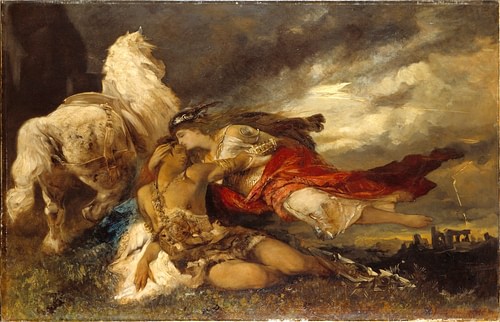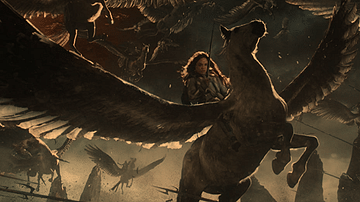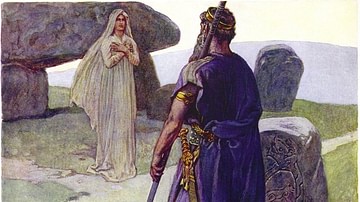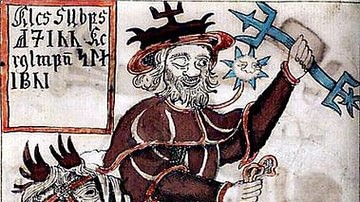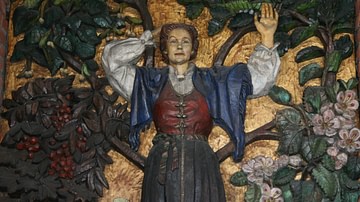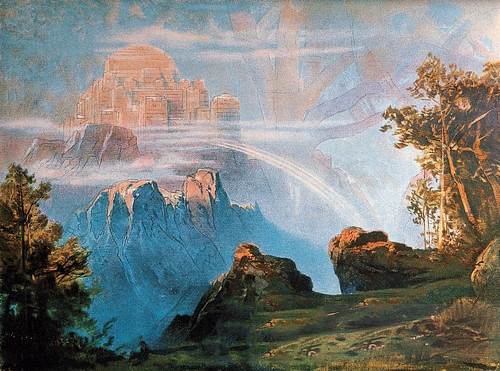
Valhalla ("Hall of the Slain") is the afterlife realm in Norse mythology for fallen heroes selected by Odin’s Valkyrie to become members of the army that will fight against the forces of chaos at Ragnarök. The concept of Odin’s Hall seems to have developed from an earlier vision of a warrior’s afterlife as a battlefield.
The name Valhalla comes from the Norse Valholl, with holl originally referring to a rock, rocks, or mountains, not a hall, and understood as Rock of the Slain. In this earlier vision, the Valkyries were understood as death demons who carried the souls of fallen warriors to a kind of eternal battlefield strewn with stones or one below a range of mountains. It is unclear when Valholl changed to the familiar Valhalla, a hall of heroes and kings served by Valkyries, but this image was established by the 10th century in the poem Grímnismál.
The Grímnismál was collected with other works in the Poetic Edda in the 13th century, and this book, along with the Prose Edda (written at the same time by mythographer Snorri Sturluson, l. 1179-1241) are the two main sources for the concept of Valhalla. The image of Odin’s Hall of Heroes is among the best known from Norse mythology and appears frequently in art, films, music, and video games. Although often referenced as the "Norse afterlife", it was only one of five (and possibly more) realms of the dead, but it is the most clearly described and most often referenced as a grand vision of the destination of fallen heroes.
Oral Tradition & Sources
Norse mythology, legend, and history were passed down orally for generations until the arrival and acceptance of Christianity c. 1000. The runic alphabet of Scandinavian countries was used only for memorial stones or conveying brief messages; runes were not meant for long texts. The tales of the gods and heroes that make up Norse mythology were memorized by the poets (skalds), who sang them for audiences and taught them to protégés who would sing them for the next generation.
By the 13th century, Christian scribes had begun to write some of these verses down, and they were collected in the work known as the Poetic Edda, which features tales committed to writing from the 10th century onwards. The Icelandic scholar and mythographer Sturluson drew on these works, others no longer extant, and the oral tradition to create his Prose Edda, the work most often referenced in the present day for Norse mythology generally and Valhalla specifically.
Sturluson is also thought to have added his own poetic flourishes to the earlier tales and is responsible for the popular misconception that Valhalla is "the Norse afterlife" because he devotes considerable detail to it. Valhalla is, as noted, mentioned in earlier works, and these often have to do with the death of a hero or tales of Odin and the coming of Ragnarök, but there were other realms for the souls of the dead – even those who died in battle – besides Odin’s Hall.
Norse Realms of the Afterlife
There were five realms the souls of the dead traveled to after life and, in some cases, no clear-cut reason why they went to one instead of another:
- Fólkvangr – realm of the goddess Freyja
- Hel – realm of the jötunn Hel
- The Realm of Ran – presided over by the goddess Ran
- The Burial Mound – one’s tomb or grave
- Valhalla – Odin’s Hall of Heroes
Besides these five, there is another alluded to in some poems known as Glæsisvellir ("Glittering Plains") also referenced as Ódáinsakr ("Field of the Not-Dead") which seems to have been an orchard or part of an orchard near Odin’s Hall. It was ruled by a wise king named Gudmund. The realm is described in the Hervarar Saga, quoted here by scholar H. R. Ellis Davidson:
Gudmund and his men lived out many men’s lifetimes and, because of this, heathen men believe that in his kingdom in the Field of the Not-Dead, and that everyone who came there turned his back on sickness and age and would not die. After the death of Gudmund, his men worshipped him and called him a god. Those who entered Gudmund’s realm were welcomed by his daughters as lovers so that his land might well be described as the Land of Women. (Myths and Symbols, 185)
Glæsisvellir may have been an early version of Fólkvangr (“realm of the people”) where, it seems, the souls of those who died natural deaths traveled. Warriors were also brought there, however, by Freyja to fill her hall Sessrúmnir ("room of many seats") and, presumably, await the coming of Ragnarök, just as the heroes of Valhalla did. Odin’s Valkyries were said to take half the heroes of any battle and Freyja the other half, but no reason is given as to why the two deities selected the ones they did. It could be that Freyja, of the Vanir family of gods, valued a different sort of hero than Odin, of the Asgardian family, or simply that they agreed to divide the fallen in half. Fólkvangr is described as a beautiful world of fields, flowers, and streams, but it is unclear why a soul wound up there instead of in Hel.
Hel was primarily for those who died of sickness or old age, but it seems that anyone, even a god, could end up there. It was not a realm of punishment but a cold land of darkness and mist presided over by the jötunn (someone from Jotunheim) Hel, daughter of Loki, who was more or less imprisoned there by Odin as Queen of the Dead. The spirit of the god Baldr goes to Hel after he is killed by his brother Hodr who is tricked by Loki into the murder. Baldr’s wife Nanna also goes to Hel as does Hodr after he is killed by Váli. None of these gods die of old age or sickness so, clearly, Hel was open to a number of different kinds of souls who, it seems, could have as easily gone to Fólkvangr or even Valhalla.
The Realm of Ran was deep beneath the sea in dark caverns where the souls of those who drowned spent their afterlife. Ran, wife of the sea god Aegir, took the souls of sailors swept from their ships and carried them down to her world where she looked after them. There is no mention of these souls ever leaving Ran’s realm, even at Ragnarök, though her undersea caves were most likely destroyed in that event with everything else in the Nine Realms of Norse cosmology.
The soul could also take up residence in its own grave or tomb after death and live out its afterlife peacefully or, if so inclined, go about terrorizing the neighborhood and causing trouble. The burial mound as one’s final destination seems to have been among the earliest beliefs and may have given rise to the concept of Valhalla in that a warrior would be buried with weapons, armor, sometimes a horse or dog, and other grave goods thought necessary in the next life. In time, this understanding of a warrior fully equipped to continue fighting encouraged the vision of a realm where many warriors lived on in a great hall where they were supplied with all they needed and practiced martial arts daily.
Valhalla
There may have been other afterlife realms or only five that were referred to by different names. Glæsisvellir could have been a version of Fólkvangr, as noted, but, as it was associated with Odin, might have also been a version of Valhalla. Davidson notes:
Certainly there seems to be no ground for the assumption that there was ever one belief in a universal land of the dead to which all travel after death. Contrasts between the realms of the supernatural world are continually made, and we have gods and giants, fair giants and frost giants…Such contrasting pictures may be fragmentary and confused, but they may also be of considerable age. One important factor which determined the fate of men after death was their rank on earth. (Myths and Symbols, 188)
This consideration is what most likely encouraged the development of Ragnarök from a field of the slain to Odin’s Hall of Heroes. Although a king or great warrior might have thought to have been content to spend their afterlife in their tomb early on, they were eventually given the great hall, shingled with golden shields as a roof and supported by the hafts of spears, better befitting their station in life and sacrifice in battle. Bright coats of mail served as cushions on the benches instead of hay and the room featured long tables at which the warriors would feast after a long day of battle, death, and resurrection.
The heroes of Valhalla were purposefully chosen as the army to be led by Odin at Ragnarök and so were thought to engage in perpetual practice for the great battle at the end of time. The hall had 540 doors – at least one with a wolf as guardian and an eagle flying overhead - through which 800 warriors could march at once, and during the day, they practiced the art of war, slaying and being slain, only to become whole again at evening and feast together. The warriors of Valhalla were known as einherjar ("army of one") understood as someone who could handle any given situation but who still honed their skills in preparation for Ragnarök, as described in chapter 41 of the Gylfaginning of the Prose Edda:
Every day, as soon as they are clothed, they straightaway put on their armor and go out into the court and fight and fell each other. That is their sport; and when the time draws near for the evening meal, they ride home to Valhalla and sit down to drink even as is said here: All the einherjar in Odin’s court/Deal out blows every day/The slain they choose and ride from the strife/Sit later in love together.
There was no shortage of food and drink because the Cook of the Gods, Andhrimnir, roasted the great beast Saerimnir (sometimes referenced as a boar) over an ever-burning flame and every evening Saerimnir regenerated to provide meat for the next day. The goat Heidrun supplies endless mead from its udders while the hart Eikthyrnir drips cool water from its antlers which provides Valhalla and all the realms with clean, clear waters.
Odin sits on his throne amidst the souls of the kings and heroes with his two ravens – Huginn and Muninn – on his shoulders. The ravens fly through the world every day and bring news back to Odin at dinner time, so he knows all things happening in the Nine Realms at all times. Odin himself does not eat with the others but only drinks wine - he feeds his portion of the meat to his two wolves, Geri and Freki – while the Valkyries who brought the souls to the hall now serve them at their tables.
Ragnarök
There is no concept of time attached to the realm of Valhalla – it does not correspond to any earthly events – and it is unknown how long the warriors fight and feast with each other, but it is understood that this is not an eternal realm. In Chapter 38 of the Gylfaginning, it is made clear that "all those men who have fallen in battle from the beginning of the world are now come to Odin in Valhalla", and the Gylfaginning later states they will remain there only until Ragnarök when they will die a second time alongside Odin, Thor, and other gods.
The Norse gods were not immortal. They were kept young and strong through the goddess Idunn and her magical apples which they needed to periodically eat of to ward off old age and death. At Ragnarök, they were as vulnerable to any weapon or danger as mortals, and a number of them, along with the great champions of Valhalla, would fall before the forces of chaos led by Loki, his children Fenrir, Jörmungandr, and Hel, and the army of the dead, the fire giants under Surtr, and others.
The tale of Ragnarök suggests that fallen warriors are chosen not only by Odin and Freyja but by Hel for her army of the dead as Chapter 51 of the Gylfaginning says "all the champions of Hel follow Loki", and "champions" is the same term used for the einherjar of Valhalla. However long the einherjar had been in Odin’s Hall, it was understood by mortals during the Viking Age (c. 790 - c. 1100) that the event which heralded the end of days – the death of the beautiful god Baldr – had already happened and the countdown to Ragnarök was already begun. People would know of its imminent approach through signs such as climate change and a breakdown in long-held values and customs.
At a given moment ordained by the Fates (known as the Norns) the forces of chaos would break the bonds the gods had held them in and attack the ordered world. Chapter 51 of the Gylfaginning describes the gathering of the armies at the battlefield of Vigrid:
When these tidings come to pass, then shall Heimdall rise up and blow mightily in the Gjallar-Horn and awaken the gods and they shall hold council together. Then Odin shall ride to Mimir’s Well and take counsel of Mimir for himself and his host. Then the Ash of Yggdrasil shall tremble and nothing then shall be without fear in heaven or in earth. Then shall the Aesir put on their war-weeds, and all the Champions, and advance to the field. Odin rides first with the gold helmet and his spear which is called Gungnir. He shall go forth against [Fenrir] and Thor stands forward on his other side.
Odin is killed by Fenrir who is then slain by Odin’s son Vidarr while Thor kills Jörmungandr, the Midgard Serpent, but dies afterwards from its poison. Loki and Heimdall kill each other, while the god Freyr is killed by the fire giant Surtr before Surtr sets the world on fire and the Nine Realms are destroyed. The heroes of Valhalla are presumed to fall in the flames of the world they have always known serving their Lord Odin, and although not mentioned, the Valkyries who selected and then served them are thought to perish at Ragnarök as well.
Conclusion
Although the heroes are killed a second time, they go down fighting bravely for the cause of order and are ultimately victorious, even in defeat, as the gods triumph over chaos and a new world rises from the destruction of the old. It has been claimed by some scholars, however, that this vision of the end of the world and rebirth is a Christian contribution to an older mythic cycle that ended with the death of the gods and the destruction of the Nine Realms, lacking the hope of resurrection. Davidson, for example, notes how early references to Valhalla indicate it was no more than another term for the land of the dead:
Valhalla, instead of a bright warrior paradise, seems indeed to be a synonym for death and the grave, described imaginatively in the poems and partly rationalized by Snorri. This world Odin ruled as God of the Dead [and] since those who fell in battle came to be dedicated to him by his worshippers, the warrior aspect would naturally come to be emphasized. (Gods and Myths, 153)
Scholar Daniel McCoy also notes how pre-Christian Scandinavian beliefs do not seem to support the concept of rebirth but emphasize instead a glorious death which will be remembered in the songs of the poets. Although this claim deserves consideration, it is nearly impossible to know what pre-Christian Scandinavian beliefs were as there is no written record of them. Archaeological evidence and later writings, however, strongly suggest a belief in the afterlife and some sort of rebirth in a realm following one’s death.
It seems probable that Valhalla was once envisioned only as a battlefield for the slain but developed into something more, either before or after the advent of Christianity, because it did not satisfy the people’s needs. Those who fell bravely for a cause would have been thought to deserve more in the afterlife than to wander a field of corpses, broken spears, and shattered helmets. The living clearly felt they deserved a golden-roofed hall of endless feasts and boundless mead surrounded by beautiful shieldmaidens in the company of the king of the gods himself. This vision offered consolation to those left behind and hope for those who regularly risked themselves in battle. Whatever Valhalla was originally, people’s need for a grander vision made it famous as the Hall of Heroes honoring the fallen who will rise to fight again.
